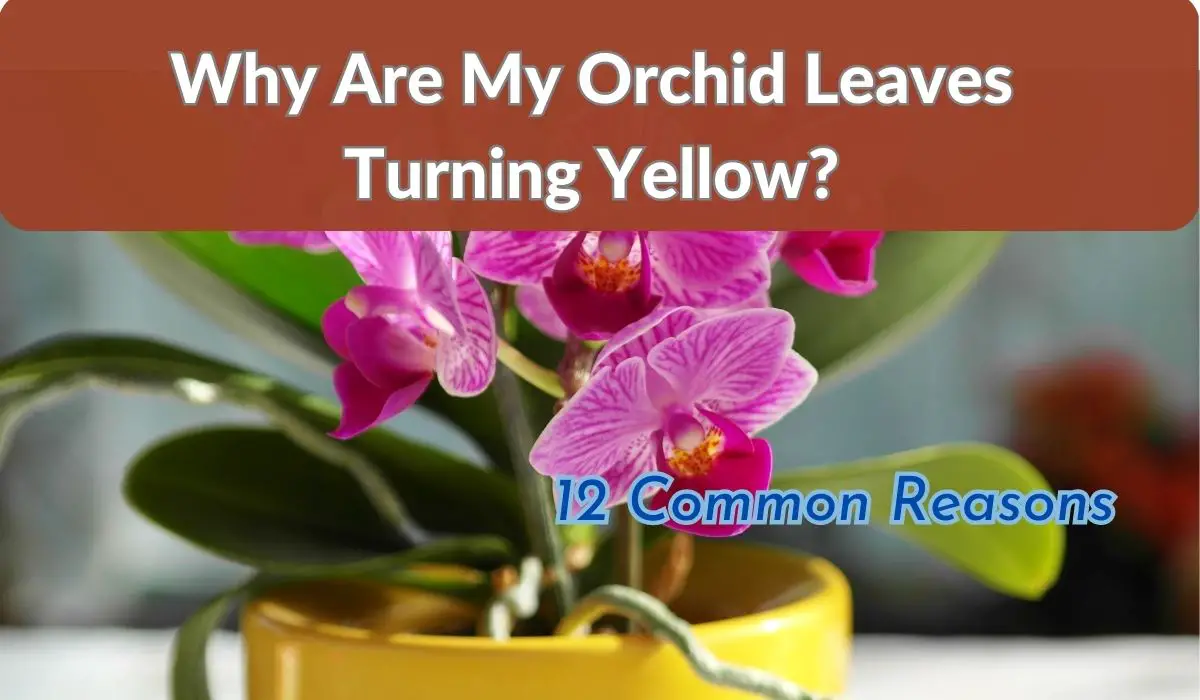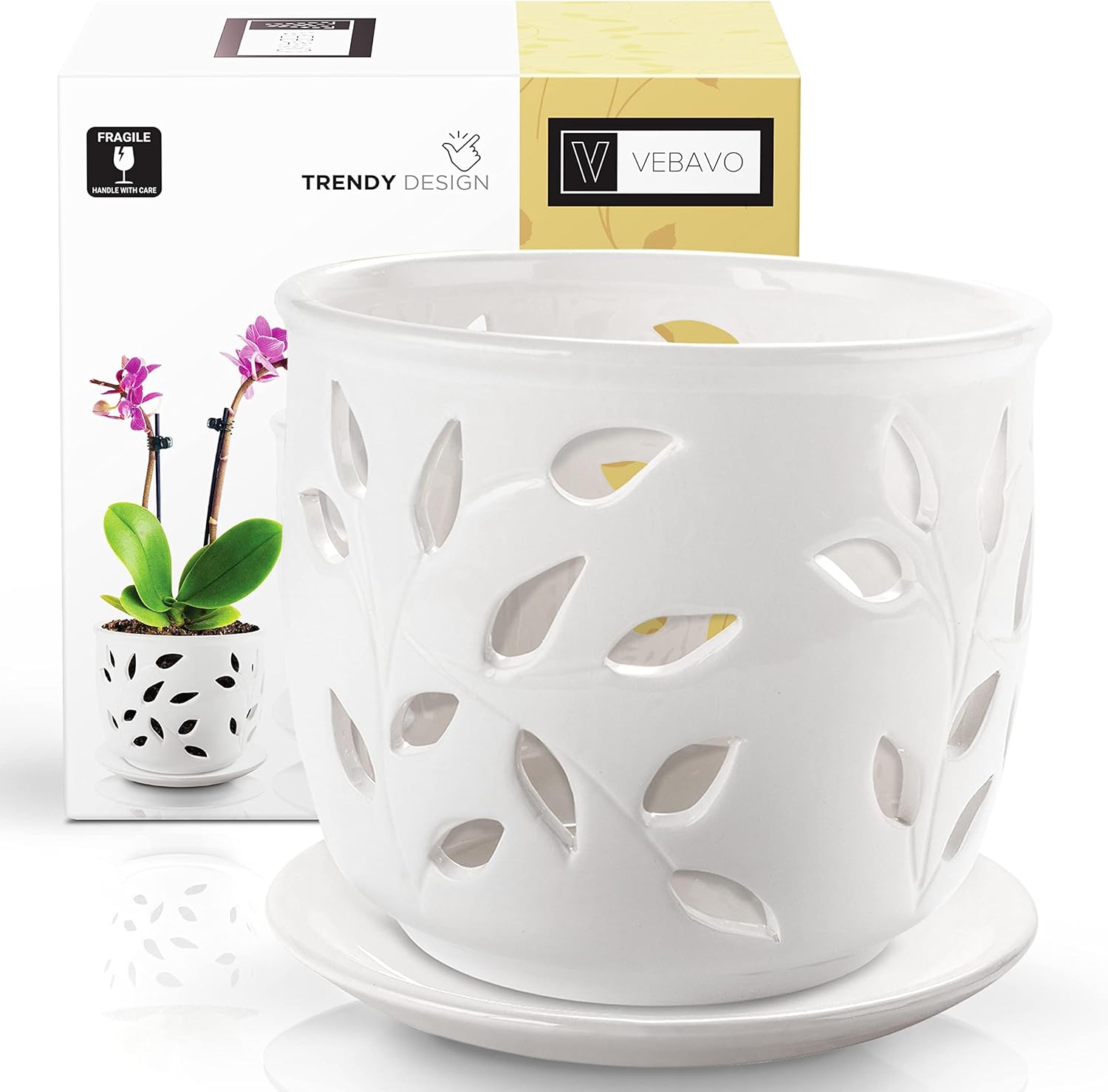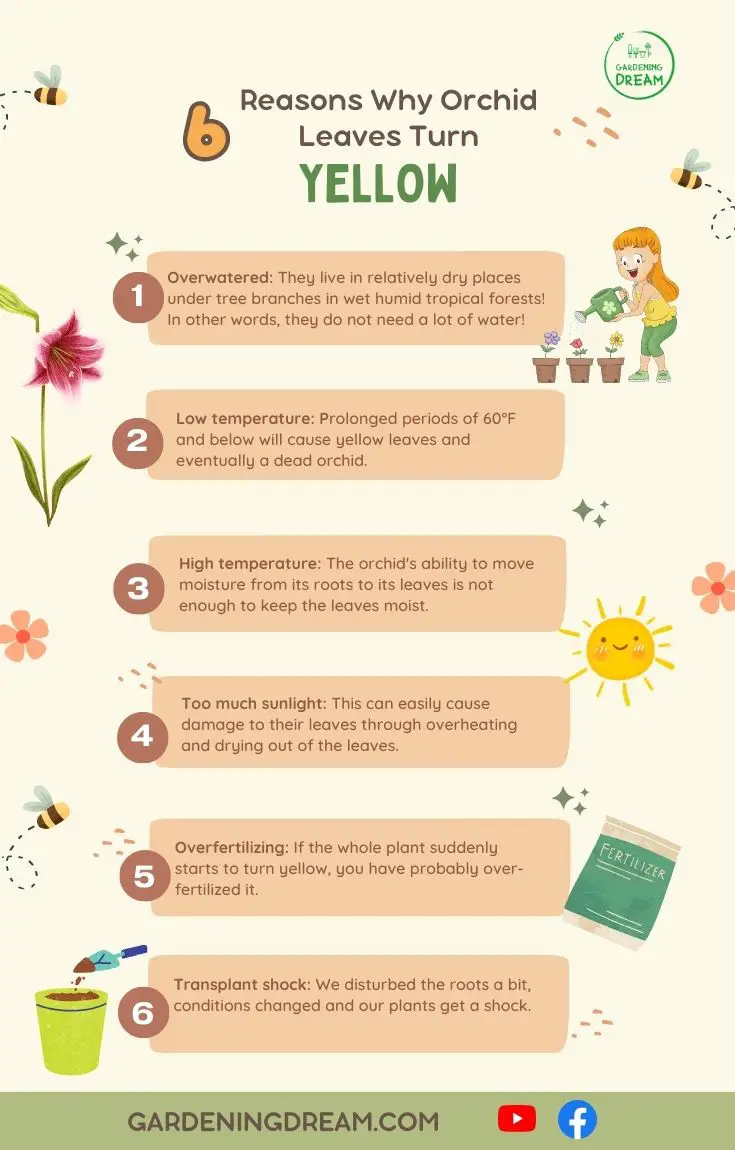Last Updated on April 20, 2023 by Tony Manhart
Why Does an Orchid Leaf Turn Yellow? In this article, we will look at 12 common reasons for yellowing leaves and look at solutions you can implement to keep your orchids alive and thriving.
Quick Summary: Why Does an Orchid Leaf Turn Yellow?
Overwatering your orchid can lead to root rot while rooting media that is low in nitrogen, magnesium, or both can result in orchid plants with yellow leaves. If they are getting too much direct sunlight orchids can also get yellow leaves.
A Quick Overview of the Global Orchard Industry
Orchids are pretty complex and difficult to grow plants in many cases. Some, such as the various Phalaenopsis hybrids produce stunning flowers and are relatively easy to grow. Phalaenopsis make up the bulk of the global orchid trade. Phalaenopsis orchids take a while to die if they are not exposed to optimal conditions, and when this happens, their leaves turn yellow, they stop flowering and then they die. Slowly.
This means they are the perfect business for big companies to crank out pretty orchids that are grown in perfect greenhouse conditions and then placed near checkout counters all over the world. Orchid purchases are normally impulse buys – somebody wants to buy a gift, and boom, they see an orchid and think “wow that’s a perfect housewarming gift”. You then get given an orchid that has been maltreated at a shop, is in flower, you know nothing about it, and you kill it slowly. The company made money, and you and your friend got scammed. Just before it dies, its leaves turn yellow.
This article shows you how to beat the odds and maybe keep your orchid alive so that you can get it to flower again. I have had some luck with this over the years but my friends have also learned not to buy me orchids anymore as I always rant and rave about this global orchid factory scam.
Phalaenopsis Orchids
If you are asking questions about an orchid the chances are it is a Phalaenopsis hybrid species orchid. These orchids are relatively easy to grow and produce beautiful flowers. Their original parent species are from warm, humid, tropical, or sub-tropical forest environments. These areas have relatively stable climates, with temperatures that range from about a minimum of 72°F to a daily high of about 90-95°F. This means that if you can keep your orchid in the 75-85°F range, it should be in the middle of the optimal temperature range for this plant.
Phalaenopsis live in humid forests – hence humidity needs to mimic what these areas would have naturally in the 60-70% humidity range. In this regard, a dry, climate-controlled house is often a bit outside the optimal humidity range of these plants and this needs to be adjusted. We will go into that shortly.
Why Does an Orchid Leaf Turn Yellow?
The simple reason for an orchid leaf turning yellow is that it is dying. There are a few common reasons for this, and here we will look at 12 of them.
12 Common Reasons Why My Orchid Leaves Are Turning Yellow
1) Overwatered
Phalaenopsis orchids cling mainly to the underside of branches of trees in nature and their roots are exposed to quite a bit of air movement. In these environments, rain falls and dribbles around the branches of the trees and they absorb the water quickly and store it in their succulent leaves. The roots are used to having a lot of air around them and consequently are adapted to have abundant oxygen available. It may sound funny, but Phalaenopsis live in relatively dry places under tree branches in wet humid tropical forests! In other words, they do not need a lot of water!
To produce orchids for sale, the growth conditions are adapted and they are grown in pots as most people do not want to have a tree branch next to their bed with an orchid growing on it. This means that the orchid roots are crammed in a pot, and, if you do not understand how to water the orchid, you will drown the roots. When this happens, the leaves go yellow and the plant dies.
Orchids are normally potted in bark or moss to try and mimic the conditions on the outside of a tree in a jungle. Water the bark once a week and allow it to dry out. The process of the potting material drying out will draw air into the system and keep the roots happy. These plants absorb water fast, and if the leaves are firm and moist, your plant has enough water. It does not need more. If you overwater the plant constantly, the roots will drown due to too much water and not enough air.
It is a good idea to put your orchid in a pot such as this to ensure that the roots have adequate airflow and drainage.
2) Low temperature
As a general rule, for many Phalaenopsis orchids if temperatures drop below about 60°F you can start to pick up a bit of leaf damage and orchid leaves turning yellow here and there will occur. Try to keep the orchids in areas where they will not be exposed to such low temperatures. A few days where temperatures briefly hit this point will not be a problem, but prolonged periods of 60°F and below will cause yellow leaves and eventually a dead orchid.
Supplemental lights can give a small amount of heat, which may be enough to solve the problem. I have a friend who grows a lot of orchids and he uses heat mats in winter to keep the root zones warm. His observation is that the heat mats provide just enough heat to keep the plants green year-round.
3) High temperature
Phalaenopsis orchids have a limited ability to absorb moisture rapidly. This is because their natural environment is relatively stable, and they lurk under tree branches in areas where the climate is moderated by a forest. In the home, sometimes temperatures can get quite high, and the orchid’s ability to move moisture from its roots to its leaves is not enough to keep the leaves moist – in this case, the leaves begin to dry out. This is a common reason for orchid leaves turning yellow.
When temperatures get over about 85-90°F and it is dry, your orchids can suffer. If the air is humid they can tolerate quite a bit higher temperatures as the rate at which the leaves dry out is quite low. I have overheated orchids a few times and found it very difficult to bring them back after this.
If you find that the majority of the leaves are withered, you can try and move your orchid to a cooler place and spray the leaves down with water regularly – sometimes they will absorb a bit through their leaves, but in general, your orchid is probably doomed if its leaves have gone yellow from heat damage.
4) Too much sunlight
This and heat, as listed above, often go together and are common reasons for orchid leaves turning yellow. Phalaenopsis orchids lurk under tree branches where they get minimal direct sunlight. If they get direct sunlight for longer periods than a few minutes, this can easily cause damage to their leaves through overheating and drying out of the leaves. These plants need indirect, good light similar to that in a tropical forest.
If you place them behind another plant such as a Jade or Money plant, or even Mother in Laws tongue plants that can absorb the brute force of the sun, the dappled light that gets to the orchids will be much like the light that would break through the canopy of the trees in a forest.
5) Calcium deficiency – Orchid leaves turning yellow and brown
If we think of the natural environment of these orchids, they would have lurked under tree branches. Birds sit on tree branches. Rain falls on the branches and the nutrients in the bird poop leach slowly over and feed the orchids. When we keep orchids in a pot with bark chips and moss, the conditions are a bit different and we do not have birds pooping in the pot. In the absence of bird poop extract, orchids in pots can become calcium deficient which causes soggy brown leaves with yellow spots and general death of leaves.
In this regard, I have always found incorporating a little bit of shell grit in my orchid potting mix helped, it never hurts to buy a professionally formulated product. The recipes used in preparing these products are very similar to the recipes used in the factory orchid farms where your orchid was produced. Often, just giving them a spritz of the foliar spray feed, and putting a stick of slow-release nutrients in the pot will restore your orchid over two to three months.
6) Magnesium deficiency – Yellow spots on orchid leaves
Magnesium deficiency will show up as a collection of yellow spots on older leaves, eventually leading to these leaves dropping. With time all the leaves will develop this problem and your orchid will die. Much like calcium, using a foliar feed and some nutrient spikes will eliminate this problem. In the past, I have had some luck using Epsom Salts at a rate of 1 teaspoon dissolved in a gallon of water, and then I used this as a foliar spray and sprayed the leaves three times a week. I find a preformulated feed that provides all the nutrients is however a lot more desirable than fiddling around with my own home remedies – orchids are expensive, and premixed nutrients are cheaper.
7) Nitrogen deficiency
A nitrogen deficiency can cause leaves to turn yellow. Too much nitrogen can cause calcium and magnesium deficiencies. The wrong type of Nitrogen can also cause yellow leaves. To understand the complex issues around how the commercial orchid industry pumps out orchids forces them to flower and flies them around the world to you, this scientific journal article is quite interesting. It is quite clear from this article that these hybrid orchids have been bred to survive on very specific nutrients, and, again, I return to the fact that the best way, is for somebody that does not have a lot of time on their hands to formulate fancy homemade nutrients.
I am not a big fan of preformulated fertilizers or anything that is not organic, but I know how fiddly orchids are, and in this regard, I am willing to accept that I just cannot win using my methods!
8) Potassium deficiency
This is one of the more common causes of orchid leaves turning yellow. Scientific studies, by orchid producers, have even mapped out how long it takes for this to kill a plant. I would guess that in most cases, for the orchid industry, the main cause of repeat sales will be a potassium deficiency.
Again, commercial growers use premixed formulas that keep the plants alive. You can duplicate these mixtures which are published in this article for example. I would however just go with a preformulate mix as listed above in the previous section 7.
9) Natural aging – Orchid leaf turning yellow
If an individual orchid leaf turning yellow is worrying you, look to see where it is. If the leaf is an old leaf, near the bottom of the stalk, it may just be being shed due to age. When orchid leaves get old, the plant moves nutrients and anything it can out of the leaf, and relocates these nutrients to new young leaves. When this happens, the leaf turns yellow, withers, and falls off.
10) Overfertilizing
If the whole plant suddenly starts to turn yellow, you have probably over-fertilized it. This is a standard error we all make at some point in our gardening careers. There is a fine line between too little, the right amount, and too much fertilizer with orchids. Generally, following the instructions on the product label, conservatively, is the best option.
When I overfertilized an orchid in the past, I found the best treatment was to dunk the whole pot in a bucket of clean water (I use rainwater), and then remove it, and let the water drain into the sink. I did this twice and washed the pot clean of nutrients, and then allowed the orchid to dry out. It took about a year to recover, but it still exists.
11) Orchid is root bound
As mentioned before, a pot is not a natural habitat for an orchid. They naturally cling under branches in trees. Their leaves and roots both store water, and in the case of an orchid in a pot, the roots can with time begin to take over the entire inner volume of the pot – this will mean that there is less airflow, and also that the roots lose their ability to absorb nutrients.
If you have had an orchid for a few years, it is always a good idea to move it into a bigger pot. In many cases, it is a good idea to repot an orchid as soon as you get it. Ann gives a lovely demo of how to do this here.
12) Transplant shock
I have found that most of the times I transplanted my orchids some of the leaves turned yellow. This is due to transplant shock – we disturbed the roots a bit, conditions changed and our plants get a shock.
It is quite important to always use a good orchid potting medium. I typically use a pine bark medium, with course bark and pearlite, that allows a lot of air to flow into the pot. You will see many mixes have sphagnum moss in them – sphagnum moss is a very unsustainable resource and the purchase thereof should not be encouraged. It also tends to compact in pots and I find it causes more trouble than it solves. Pine bark and pearlite work better and are sustainable.
I recommend you read the following article so that you can continue taking care of your orchids after blooming.
In Conclusion:
Overwatering your orchid can lead to root rot while rooting media that is low in nitrogen, magnesium, or both can result in orchid plants with yellow leaves. Yellow leaves because of overwatering are a problem; the roots are dying and can no longer transport water or nutrients around the orchid. If they are getting too much direct sunlight orchids can also get yellow leaves. Following the suggested treatments for the 12 common problems listed above will help you keep your orchids alive.
Dr. Garth A. Cambray is a Canadian/South African entrepreneur and beekeeper with 28 years of experience in apiculture and specializes in adding value to honey. His Ph.D. research developed a new advanced continuous fermentation method for making mead that has resulted in a number of companies globally being able to access markets for mead. His company, Makana Meadery, exports honey mead to the USA where it is available to discerning connoisseurs. He has also developed technologies to commercially manufacture organic honey vinegar in Zambia for export globally. He holds a few patents globally in the ethanol industry and believes in technology and knowledge transfer for human development and environmental sustainability. One of his proudest achievements is the fact that the wind farm he started at one of his old apiary sites has essentially made his hometown carbon neutral.





